Physical Science Paper 1 Grade 12 Questions - NSC Past Papers And Memos September 2020 Preparatory Examinations
Share via Whatsapp Join our WhatsApp Group Join our Telegram GroupINSTRUCTIONS AND INFORMATION
- Write your full NAME and SURNAME in the appropriate space on the ANSWER BOOK.
- Answer ALL the questions.
- You may use a non-programmable calculator.
- You may use appropriate mathematical instruments.
- Number the answers correctly according to the numbering system used in this question paper.
- You are advised to use the attached DATA SHEETS.
- Show ALL formulae and substitutions in ALL calculations.
- Give brief motivations, discussions, et cetera where required.
- Round off your final numerical answers to a minimum of TWO decimal places.
- Start EACH question on a NEW page.
- All diagrams are not necessarily drawn according to scale.
- Write neatly and legibly.
QUESTIONS
QUESTION 1: MULTIPLE-CHOICE QUESTIONS
Four possible options are provided as answers to the following questions. Choose the answer and write only the letter (A–D) next to the question number (1.1–1.10) in the ANSWER BOOK, for example 1.11 D.
1.1 Vuyo, the driver of a minibus that is moving at a constant velocity, on a horizontal road, sees that the sliding door of the minibus is open. He suddenly applies his brakes and the door closes. Which ONE of the following Physics laws or principles best explains why Vuyo could close the door?
- Law of conservation of mechanical energy
- Principle of conservation of linear momentum
- Newton’s First Law of Motion
- Newton’s Second Law of Motion (2)
1.2 A 2 kg mass piece is placed on a 2 kg trolley, which is at rest on a frictionless horizontal surface. When a force F is applied on the trolley, it accelerates with an acceleration of a as shown in FIGURE 1. A 1 kg mass piece is then placed on the trolley with the 2 kg mass piece and the same force F is applied on the trolley as shown in FIGURE 2.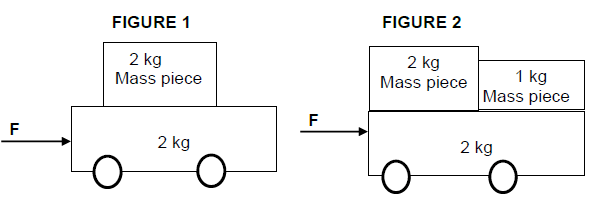
What will be the acceleration of the trolley in FIGURE 2?
- 1 a
4 - 2 a
3 - 4 a
5 - 5 a (2)
4
1.3 Two cars are involved in an INELASTIC head-on collision. Which ONE of the following combinations correctly describes the kinetic energy and the momentum of the system?
| TOTAL KINETIC ENERGY | TOTAL MOMENTUM | |
| A | Not conserved | Conserved |
| B | Conserved | Not conserved |
| C | Conserved | Conserved |
| D | Not conserved | Not conserved |
(2)
1.4 The graph below shows the relationship between the power delivered by the engine of a car and the average speed of the car.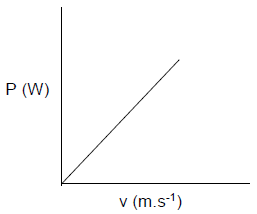
The gradient of the above graph represents the …
- momentum of the car.
- work done by the engine of the car.
- kinetic energy of the car.
- applied force of the engine on the car. (2)
1.5 A ball is dropped from a certain height. Which ONE of the position versus time graphs below best represents the motion?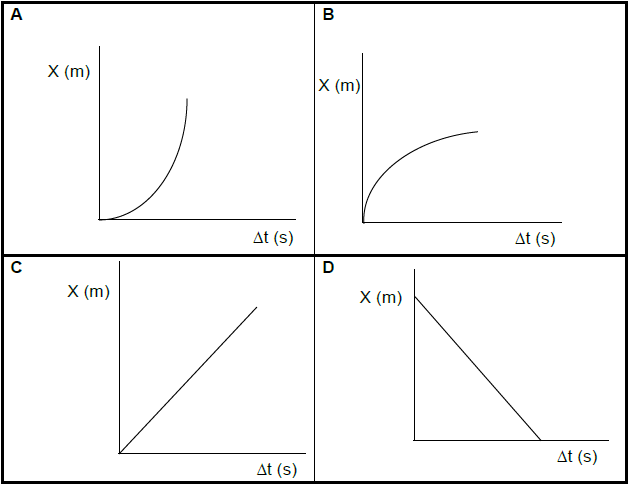
(2)
1.6 … is the main principle applied when measuring the rate of blood flow or the heartbeat of a fetus in the womb.
- Photoelectric effect
- Doppler effect
- Huygen’s principle
- Diffraction (2)
1.7 The electrostatic force between two point charges that are placed a distance r apart in a vacuum is F.
The distance between the charges is changed and the electrostatic force between them changes to 16 F. What is the new distance between the point charges in terms of r?
- 8 r
- 1 r
8 - 4 r
- 1 r (2)
4
1.8 Three identical resistors are connected to a battery as shown on the circuit diagram below. The resistance of the connecting wires can be ignored.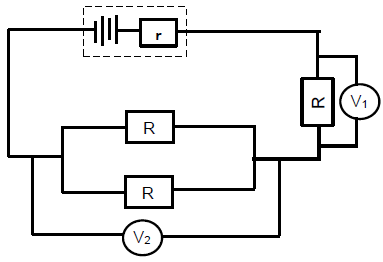
Which ONE of the following best represents the relationship between the readings of the voltmeters?
- V1 = ½ V2
- V1 = 2 V2
- V1 = V2
- V1 = ⅓ V2 (2)
1.9 The maximum emf of an AC generator can be increased by ...
- changing the polarity of the magnets.
- using larger slip rings.
- using larger brushes.
- increasing the number of turns on the coil. (2)
1.10 In a house, appliances are usually connected in parallel to each other because …
- the resistance of each resistor will decrease.
- each appliance can operate independently.
- the current supply to each appliance will be higher.
- each appliance will have maximum voltage.
Which ONE of the following combinations about reasons for connecting appliances in parallel in a house is correct?
- (i) and (ii) only
- (i), (ii) and (iii) only
- (ii), (iii) and (iv) only
- (i), (ii), (iii) and (iv) (2)
[20]
QUESTION 2
A block of mass 22 kg is placed on a rough inclined surface and is connected to a 15 kg block which hangs vertically by means of a light inextensible string passing over a frictionless pulley, as shown in the diagram below. When the inclined surface is at an angle ? to the horizontal, the 15 kg block moves downwards (as shown by the arrow alongside the diagram) at a CONSTANT VELOCITY.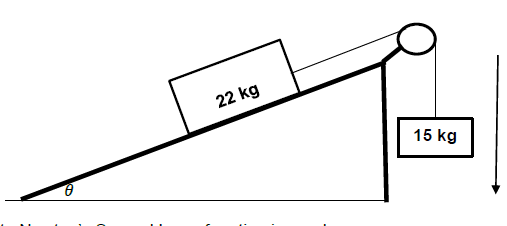
2.1 State Newton’s Second Law of motion in words. (2)
2.2 Draw a labelled free-body diagram of all forces acting on the 22 kg block. (4)
2.3 A constant frictional force of 43,86 N acts on the 22 kg block. Calculate the magnitude of the angle ? that will keep the system moving at a constant velocity.
(4)
2.4 A force of 172 N is now applied on the 22 kg block and the system of blocks accelerates down the slope. The kinetic frictional force acting on the 22 kg block while it accelerates downward remains the same.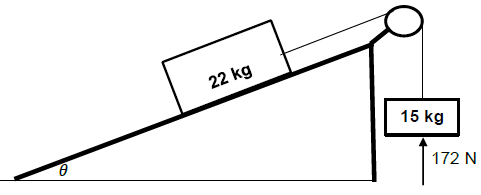
2.4.1 Explain why the kinetic frictional force remains the same even though the system accelerates. (2)
2.4.2 Calculate the acceleration of the system of blocks. (6)
[18]
QUESTION 3
A ball of mass 500 g is thrown vertically downwards with a velocity of 3,28 m.s-1 from the top of a 30 m high building, point A. After 1,2 s the ball passes the top edge of a window and goes on to hit the ground below. The ground exerts a force of 205 N on the ball and it bounces off to a maximum height ∆y, which is at the same level as the lower edge of the window, as shown in the diagram below. The ball is in contact with the ground for 0,1 s. Ignore the effects of air resistance.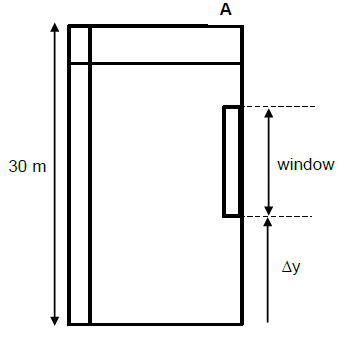
Calculate the:
3.1 Velocity of the ball after 1,2 seconds (3)
3.2 Displacement of the ball after 1,2 s of its motion (4)
3.3 Magnitude of the velocity with which the ball hits the ground (3)
3.4 Velocity with which the ball bounced off the ground (4)
3.5 Length of the window (5)
[19]
QUESTION 4
During a demonstration to determine the recoil velocity of a certain type of gun, a bullet of mass 5 g is fired from a gun of mass 5 kg. The bullet moves horizontally at a constant velocity into a wooden block of mass 2 kg that hangs vertically from a ceiling by means of a light inextensible string. The block-bullet system swings to a vertical height of 6 cm above its original position as shown in the diagram below. Ignore the effects of air resistance.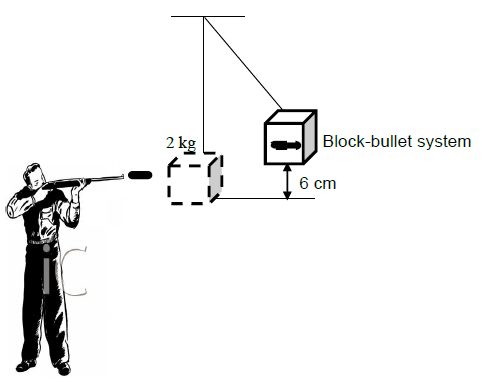
4.1 State the principle of conservation of linear momentum in words. (2)
4.2 Suppose that the original position of the wooden block is zero position. Calculate the:
4.2.1 Velocity of the bullet before it entered the wooden block (5)
4.2.2 Recoil velocity of the gun (3)
[10]
QUESTION 5
A skateboarder skates from point A of the track, which is at a vertical height of 15 m, and aims to come to rest at point D on the other side as shown on the diagram below. Section AB is frictionless while BC and CD are rough. The combined mass of the skateboarder and the skateboard is 55 kg. The skateboarder experiences a frictional force of 15 N while moving from point C to point D. Ignore the effects of air resistance.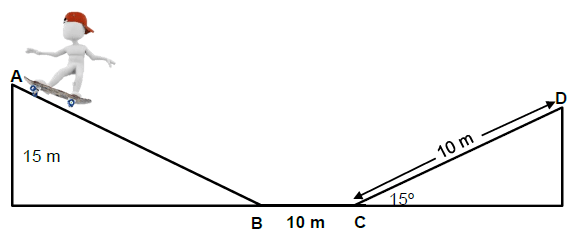
5.1 State the principle of conservation of mechanical energy in words. (2)
5.2 Calculate the kinetic energy of the skateboarder at point B. (3)
5.3 State the work-energy theorem in words. (2)
5.4 Use energy principles to calculate the:
5.4.1 Kinetic energy of the skateboarder at point C (4)
5.4.2 Magnitude of the frictional force along BC that will enable the skateboarder to come to rest at point D (5)
[16]
QUESTION 6
A laboratory assistant conducted an experiment to determine the frequency of a tuning fork. The tuning fork is set on vibration and mounted on a stand as shown in the inserted sketch. He then moves towards and away from the tuning fork with a detector which records the frequency of sound emitted by the tuning fork. The graph below represents the results he recorded. Take velocity of sound in air as 340 m.s-1.
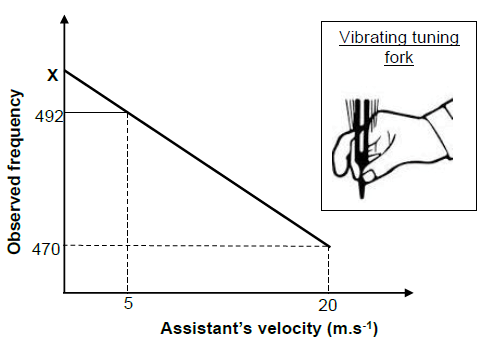
6.1 Name the phenomenon represented on the graph. (1)
6.2 Does the graph represent the instance when the laboratory assistant was moving TOWARDS or AWAY from the tuning fork? Explain your answer. (2)
6.3 Write down the relationship between the laboratory assistant’s velocity and the observed frequency. (2)
6.4 What does X, the intercept on the vertical axis, represent? (2)
6.5 Calculate the frequency of the tuning fork. (5)
6.6 The laboratory assistant intends to use the tuning fork to produce oscillations with wavelength of 0,71 m for a Grade 10 demonstration lesson. Use a calculation to determine whether or not the tuning fork will be suitable for the demonstration. (3)
[15]
QUESTION 7
A small, charged sphere X carrying a charge of +2 x 10-6 C is placed in a vacuum. When another small sphere Y of mass 5 mg carrying a negative charge is placed at point P, it accelerates from rest to a velocity of 6,25 x 103 m.s-1 just before sphere Y touches sphere X. The time taken for sphere Y to reach sphere X is 2 x 10-3 seconds.
7.1 Calculate the number of electrons that were removed from the sphere X to obtain the charge on the sphere. (3)
7.2 Draw the electric field pattern around the charges while sphere Y is still at point P. (3)
7.3 Calculate the:
7.3.1 Net electric field strength at point P due to the charged sphere X (6)
7.3.2 Distance between the charges before sphere Y moved (3)
7.3.3 Charge on sphere Y (4)
[19]
QUESTION 8
In an experiment to determine the emf (ε) and internal resistance r, of a battery, a group of learners connected the circuit diagram below. They recorded the ammeter and voltmeter readings. They repeated the experiment each time with a different resistance.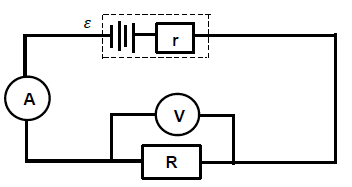
Their results are plotted in the graph below.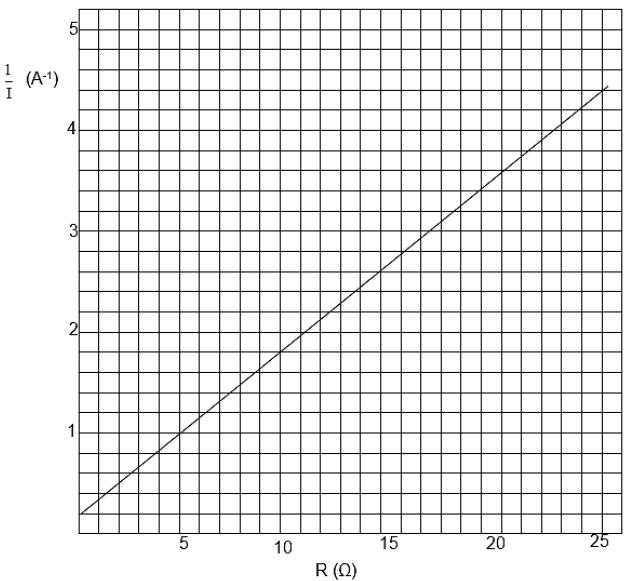
8.1 What is the independent variable for this experiment? (1)
8.2 Using the equation 1 = R + r calculate the:
I emf
8.2.1 Emf ? of the battery (4)
8.2.2 Internal resistance of the battery (3)
8.3 In the circuit diagram below the battery used in the above experiment is connected to three resistors and a toy car that is rated at 3 W, 1,5 V.
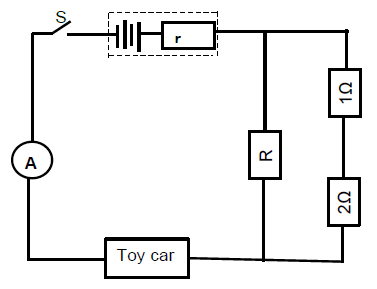
When the switch S is closed, calculate the:
8.3.1 Reading on the ammeter (3)
8.3.2 Resistance of resistor R (6)
8.4 If the resistor R is removed from the circuit, will the toy car be able to operate as rated? Answer only YES or NO. Explain your answer. (3)
[20]
QUESTION 9
A learner built an electrical device for her Eskom Expo science project as shown below.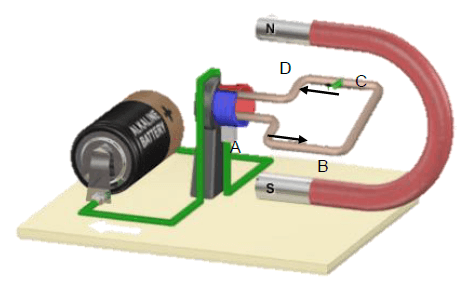
9.1 What is name of the electrical device represented above? (1)
9.2 State the energy conversion taking place in this device. (2)
9.3 If current flows in the device as indicated by the arrows in the diagram above, in which direction will section AB rotate? Answer CLOCKWISE or ANTI- CLOCKWISE. (1)
9.4 Her teacher advised her to modify the above device into one that can supply households with electricity. How can she modify the device for the desired purpose? (2)
9.5 A kettle rated at 1 500 W is plugged into a wall socket that supplies 230 V. Calculate the:
9.5.1 Resistance of the conducting coil in the kettle (3)
9.5.2 Maximum (peak) current that passes through the kettle (4)
[13]
TOTAL: 150
DATA FOR PHYSICAL SCIENCES GRADE 12
TABLE 1: PHYSICAL CONSTANTS
NAME | SYMBOL | VALUE |
Acceleration due to gravity | g | 9,8 m•s-2 |
Universal gravitational constant | G | 6,67 × 10-11 N•m2•kg-2 |
Speed of light in a vacuum | c | 3,0 × 108 m•s-1 |
Planck's constant | h | 6,63 × 10-34 J•s |
Coulomb's constant | k | 9,0 × 109 N•m2•C-2 |
Charge on electron | e | -1,6 × 10-19 C |
Electron mass | me | 9,11 × 10-31 kg |
Mass of earth | M | 5,98 × 1024 kg |
Radius of earth | RE | 6,38 × 103 km |
TABLE 2: FORMULAE
MOTION
| vf = vi + aΔt | Δx = ViΔt + ½aΔt2 or Δy = ViΔt2 + ½aΔt2 |
Vf2 = Vi2 + 2aΔx or Vf2 = vi2 + 2aΔy | Δx = [Vi + Vf]Δt or Δy = [Vi + Vf]Δt |
FORCE
Fnet = ma | p= mv |
fsmax = µsN | fk = µkN |
FnetΔt = Δp | w =mg |
F = Gm1m2 | g = G M |
WORK, ENERGY AND POWER
W =FΔxcosθ | U= mgh or EP = mgh |
K = ½mv2 or Ek = ½mv2 | Wnet = ΔK or Wnet = ΔEk ΔK = Kf −Ki or ΔEk =Ekf − Eki |
Wnc= ΔK + ΔU or Wnc= ΔEk + ΔEp | P = W Δt |
Pav = Fv |
WAVES, SOUND AND LIGHT
v = f λ | T =1/f |
fl = v ± vl fs fl = v ± vl fb | E = hf or E = h c |
E = W0 + Ek where | |
ELECTROSTATICS
| F = kQ1Q2 r2 | E = KQ |
E = V | E = F |
V = W | n = Q |
ELECTRIC CIRCUITS
R = V | emf (ε) = I(R + r) |
RS = R1 + R2 + ....... | q = I Δt |
W = Vq | P= W |
ALTERNATING CURRENT
I rms = Imax | Paverage = VrmsIrms |